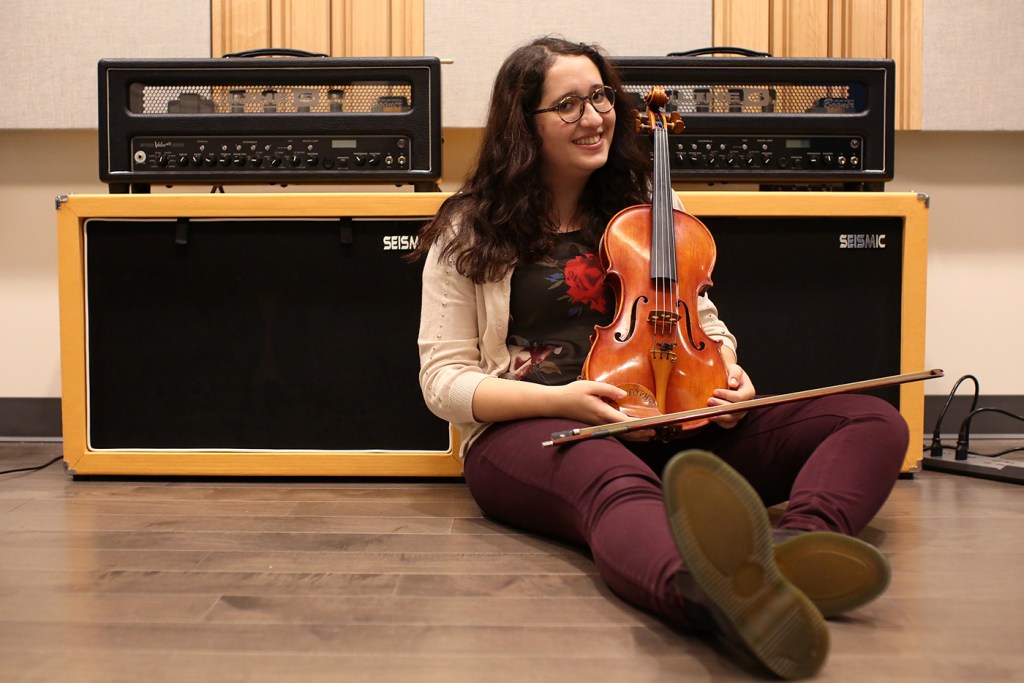The sound of success

Victoria Suha’s academic journey through the acoustics field began in adolescence, long before she founded Northeastern’s student chapter of the Acoustical Society of America and started working in the university’s Auditory Modeling and Processing Lab.
As a kid, Suha played viola in the Colorado Springs Youth Symphony. Every other year, the ensemble toured a new country— China, Australia, and New Zealand among them— and Suha performed in a new concert hall. The experience, she says, kindled her passion for the science of sound. “I developed an appreciation for architectural acoustics and the power of music,” recalls Suha, now a third-year electrical engineering major.
Her incipient interest in acoustics reached its apogee in 2010, during a viola lesson. At one point, she played two notes simultaneously—a musical technique known as a double stop—and then heard a third distinct tone. The original discovery of the psychoacoustic phenomenon, known as combination tones, is credited to 18th-century composer and violinist Giuseppe Tartini, but neither Suha nor her instructor could explain the occurrence. Suha endeavored to investigate, recalling that “I needed to find out what this was all about.” In short order, she wrote a research paper on the phenomena, tying together her interests in math and music.
Over the past two years, Suha has fine-tuned her academic focus through research positions in campus labs and leadership roles in student groups. In her first year at Northeastern, she connected with Michael Epstein, the director of the AMPLab whose research focuses on bridging the gap between physiological representations of loudness and perceptual loudness in human listeners. “We had a lot of research interests in common,” Suha says, “and he let me continue my work in his lab.”
Suha started immediately, conducting experiments beginning in the summer of 2013; less than one year later, she presented her yet-unpublished paper—Perception of Combination Tones Correlated with Cochlear Activity—to the throng of acousticians at the 167th meeting of the Acoustical Society of America.

Mary Florentine, Suha’s mentor, says that Suha comprises the perfect attitude and academic makeup to achieve her professional dream of designing symphony halls. Photo by Brooks Canaday/Northeastern University
In the meantime, she was named secretary of the ASA’s Greater Boston chapter and founded the city’s first student chapter, which is run out of the College of Engineering. The meetings routinely include guest speakers, like renowned audiology specialist Brian Fligor and recording engineer Tim Reppert. From time to time, the acousticians-in-training take field trips to recording studios and world-famous exhibits like Boston’s Mapparium, whose three-story tall globe of stained glass produces striking acoustical effects. Six weeks ago, the group hosted audio engineers from Bose, who helped the students build their own loudspeakers.
“We want to create a cross-disciplinary community of people who are interested in acoustics,” says Suha, noting that she intends to build a relationship with the School of Architecture and the Bouvé College of Health Sciences.
After Northeastern, Suha plans to earn her master’s in acoustics and pursue opportunities that would allow her to combine her interests in engineering and psychoacoustics. Her fantasy gig: becoming a symphony hall designer.
Mary Florentine, her mentor, is the co-adviser of Northeastern’s student chapter of the ASA and the George J. & Kathleen Walters Matthews Distinguished Professor in the department of communication sciences and disorders. She says that Suha comprises the perfect attitude and academic makeup to achieve her dream. “When I first met Victoria, I was attracted to her enthusiasm and joy of learning about anything related to acoustics,” says Florentine, who specializes in psychoacoustics. “A career designing concert halls requires that person to be self-motivated, passionate, and multi-talented, and Victoria has all three qualities.”




